Musings
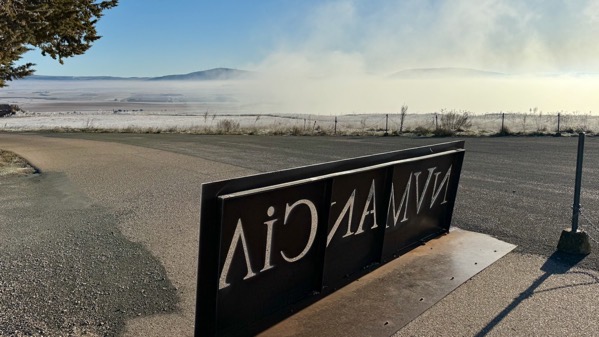
Today’s first stop was Numancia, one of the many locations that had pre-CeltIberian settlement, then CeltIberian, then a big rehab/redo by the Romans (who took it in 133 BC). As an additional treat, clouds brought moisture that the temperature converted into ice crystals.
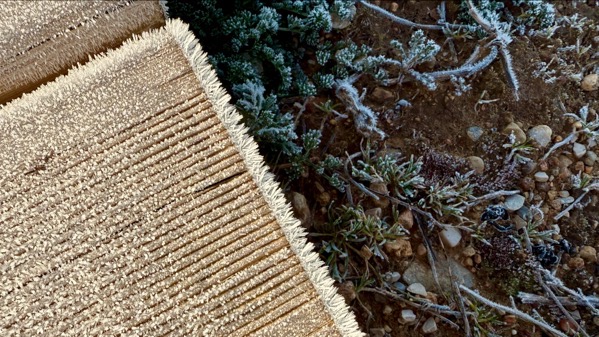
Need I mention that we walked carefully?
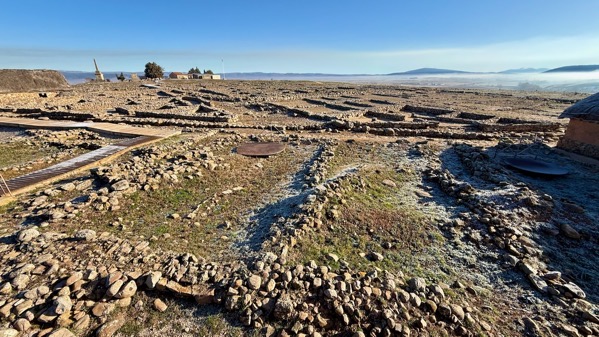
Walls, hence occupation, seemingly go on forever.
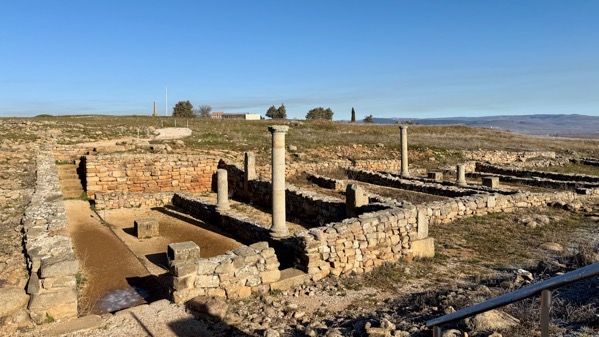
A fancier dwelling….
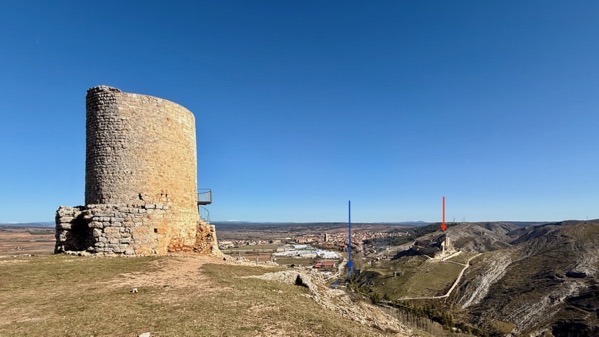
On to Uxama. This tower dates to the al-Andalusian period, when Arabs controlled most of the peninsula, including this area. They built many watch-towers to consolidate and maintain their power. It worked for generations…until it didn’t. The castle to the right (red arrow) dates to the 10th–11th C, with later modifications. The river in between (blue arrow) is the Ucero.
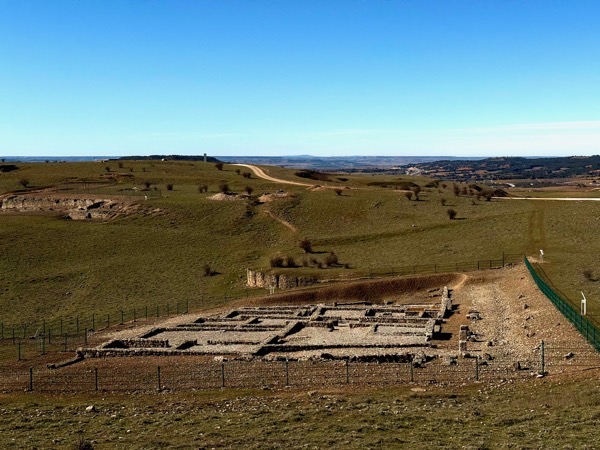
Uxama is better known as a Roman city. If all this area had buildings, it was a very large city (I am not sure that it did). This excavated area is between the major hilltops; this view is to the southwest.
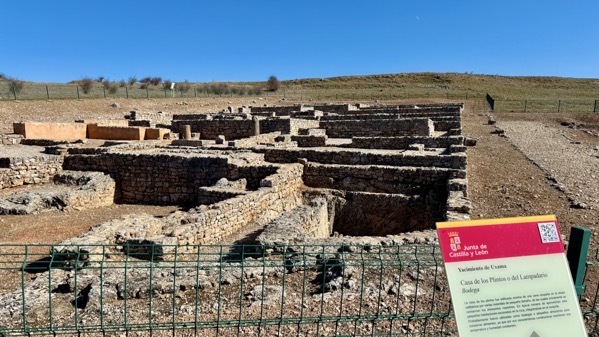
The domestic complex in this corner of this area includes and underground store-room (far right; bodega in Spanish).
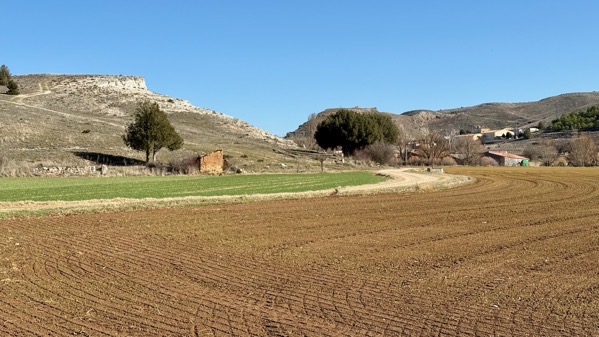
We left the Roman world behind and checked out the Riaza valley near Montejo.

I’m guessing this is wheat. I’m guessing it’s doing pretty well. We’ve been seeing large piles of bales of wheat straw, just rotting…it appears they bale it with no market…is there a subsidy involved? Just trying to figure out the political economy….
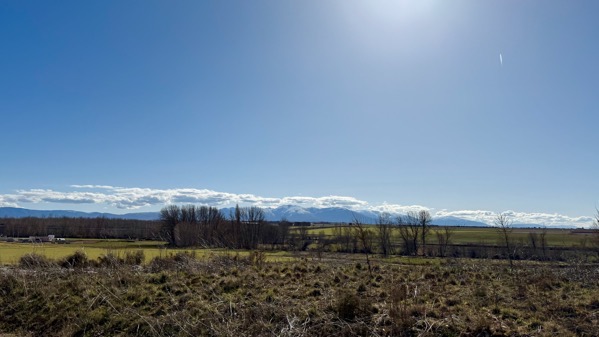
See those lovely mountains below the narrow cloud layer? Tonight’s room is in a tiny village in their foothills.
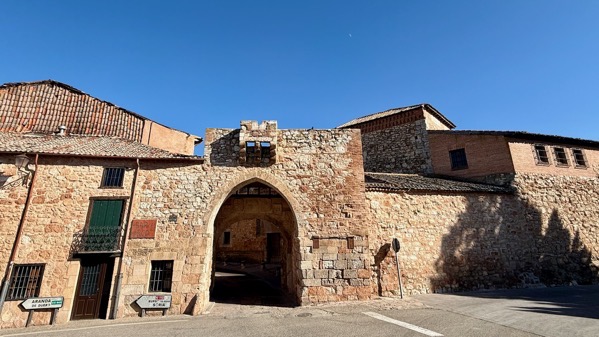
We motored through this Medieval gate to check out central Ayllón.
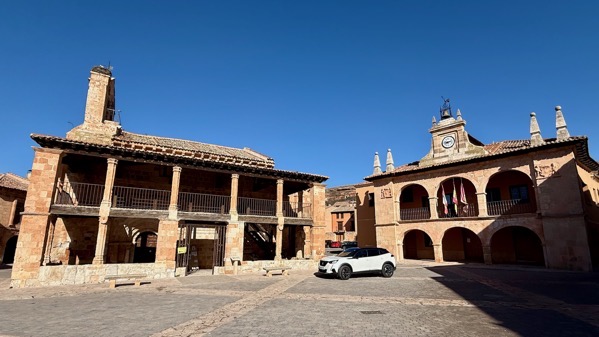
Two civic-ceremonial buildings on the mostly Medieval main plaza…. I think the one on the left was a church, and perhaps still is, but the signs relate to non-religious usage.
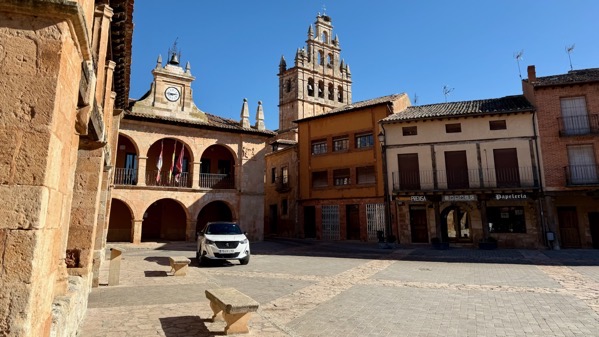
A different view of this same end of the Plaza Major.
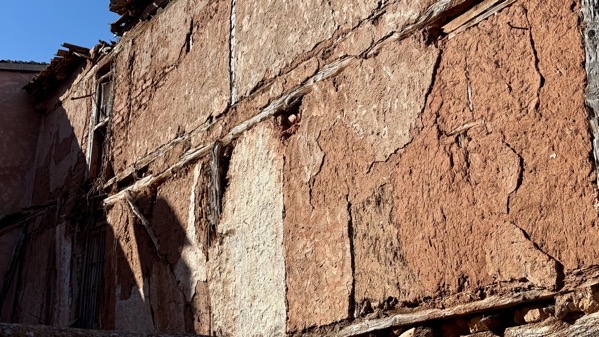
Construction detail…showing beams embedded in soft brick and adobe-type wall materials.
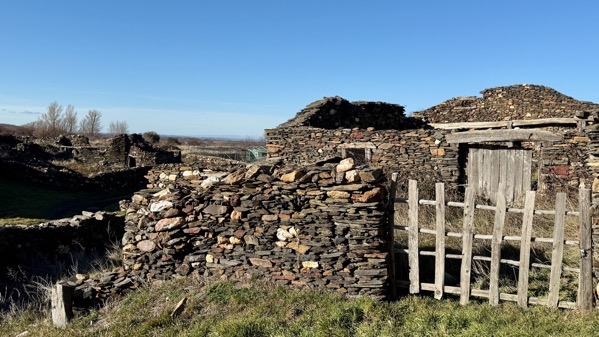
In contrast, this is the building material of the small village we’re staying in. I’m calling it slate.
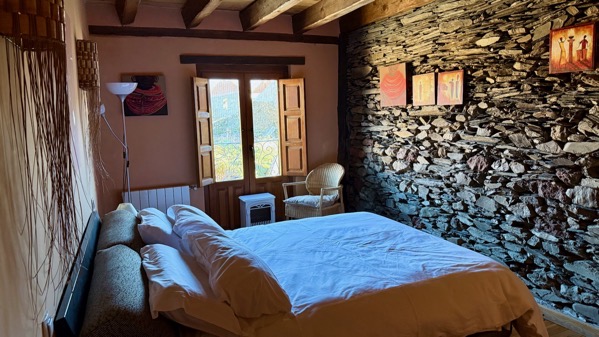
It’s even visible on one wall of our lovely room.
Posted at 12:44 PM |
Comments Off on Beyond Roman-ness

Wind turbines on horizon. Strange color balance (through windshield).

Frost patterns…one shady place we saw frost as late as 11:30am.

Flags, bell tower.

Storks, backlit.

Horses, also backlit, with frost, tracks.

Medieval rock graves, Revenga.

Medieval rock graves, Regumiel. They antedate the 12th C church built partially atop them.

Medieval rock graves with ice skim, Duruelo. Some sources say this trend in this area, the Upper Arlanza Basin, say these graves are 7th/8th C. Others say 8th–10th C.

Stand-alone snow-capped mountain, perhaps Moncayo.

Wind turbine array, with Pyrennees in far distance and Ebro basin between.

Rioja territory grapevines.

This is the part of the Roman city of Graccurris, founded 179 BC, that has been “reconstructed.” I could make little architectural sense of what seemed to me to be mostly a wasteland. Of course, there was significant Medieval occupation here, too….

Largest church in Alfaro, essentially modern Graccurris.

Smaller Alfaro church.

Fuzzy moon out our hotel window, a few minutes ago.
Posted at 1:57 PM |
2 Comments »

Our room last night had a pair of those arched windows on the third story (second above ground floor) that have gold framing. I learned that if you live in a place with narrow streets and multi-story buildings, like this neighborhood, you may not see much sunshine.
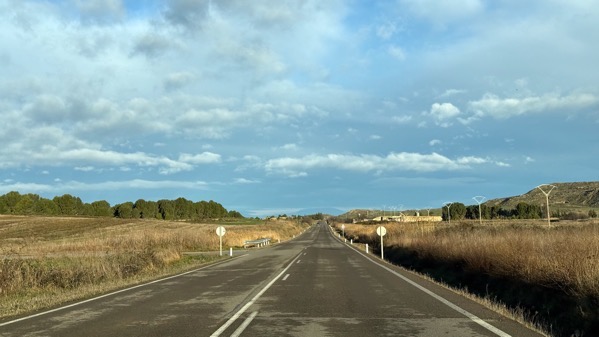
Ah, there is sunshine after last night’s rain.
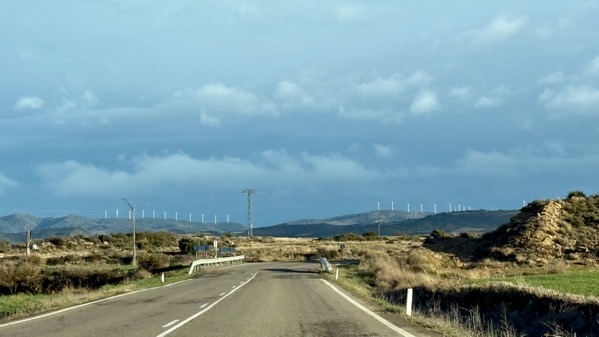
Is MaNachur offering some kind of irony in lighting up the wind turbines?
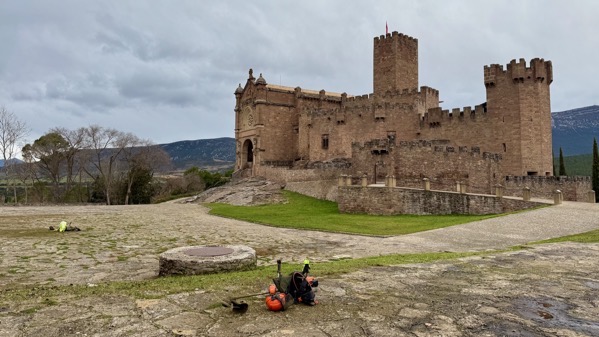
I wanted to see this church-castle-tower combo for the massive high walls on the tower. I did not expect to have the quirky bonus of arriving when the grounds crew was taking a break, leaving their equipment to mark the spots where they should resume, and highlighting that the priests rely on so much outside labor to strut their stuff.
This is the Castle of Xavier (Basque: Xabierko gaztelua), and the name Xavier/Javier is derived from the Basque Etxeberri meaning new house. [However difficult we thought Catalan was to grasp, I find Basque words impossible.] The Basque Jesuit cleric and famous proselytizer Francis Xavier (1506–1552; canonized 1622) was from here, taking the name of his hometown as his priestly cognomen (or whatever they’re called). Xavier is now used by many institutions, including Xavier University in Cincinnati, Ohio, to honor the man.
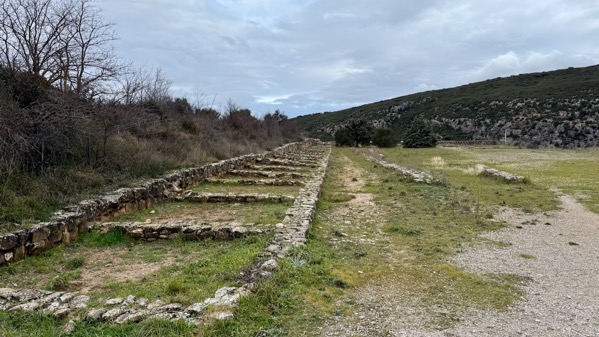
Changing gears, the is the entry area for the Villa Romana de Liédena, which was occupied from the 1st through 4th Cs AD, with its greatest size and decorative opulence at the end, including various mosaic floors. This was a villa, so an agricultural complex and a fancy dwelling complex merged together.
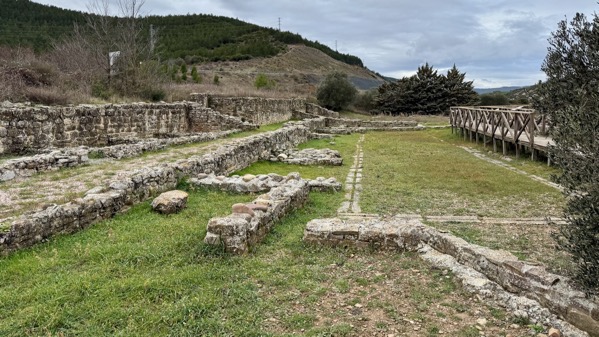
A visitor, it seems to me, would pass through the agricultural entry area and into this impressive patio that featured an open-water pool (the narrow-double-stones outline it) that drained toward the lower left of the photo and away from the house.
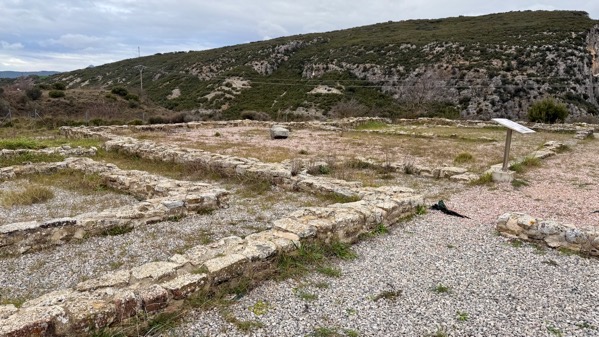
This large room was perhaps the core of the elite dwelling.
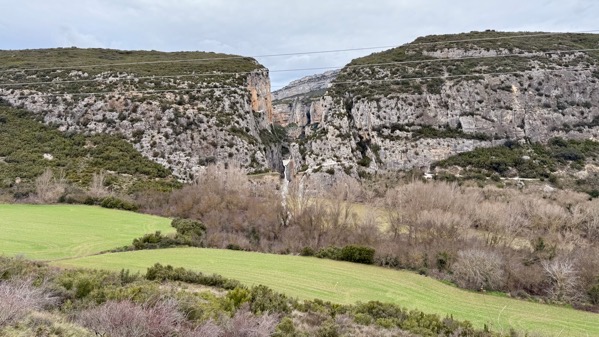
The villa’s location was chosen with this fabulous view of the Foz de Lumbier, or Lumbier Canyon, with the Río Irati in between, as well as the fields this villa controlled.
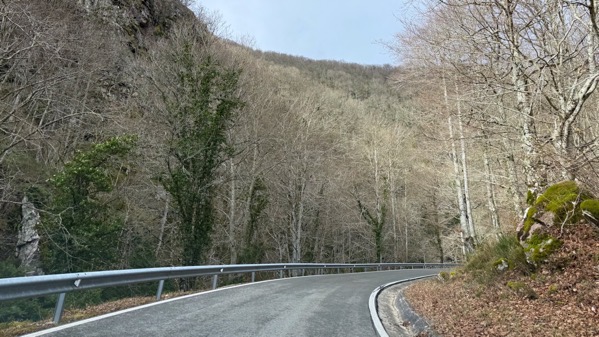
Next, we followed the Río Urrobi upstream a long ways. We had some precip, but thankfully it was too warm for the snowflake warning signs at the higher elevations to reflect our current situation.
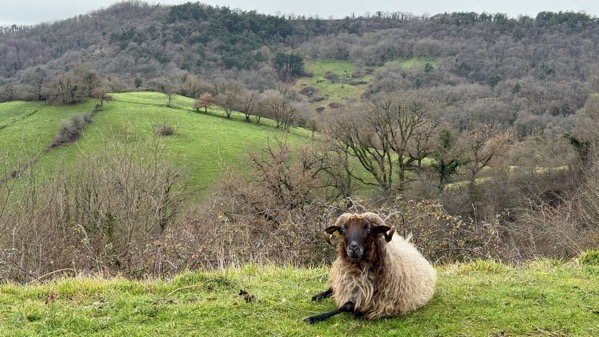
Despite many signs cautioning us about open range animals, this is one of the first we’ve seen, only a trifle worried that we’ve stopped moving.
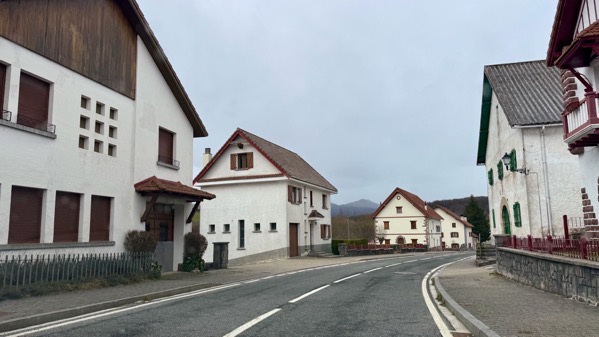
This is the typical domestic architecture in these parts…very different.
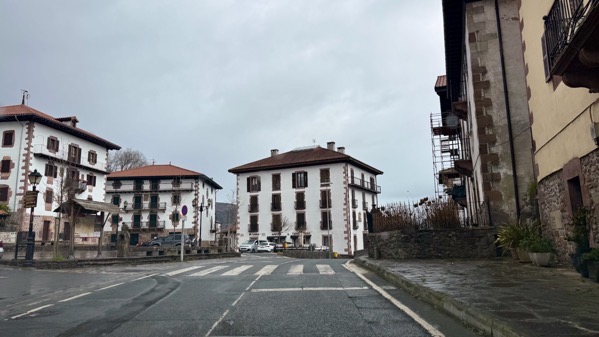
Sometimes, the homes are slightly fancier.
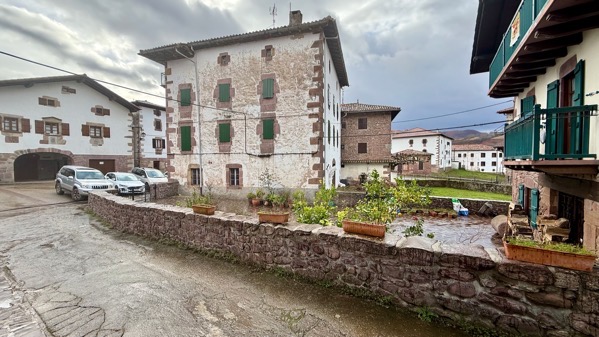
Our guesthouse is to the right, with the green shutters.
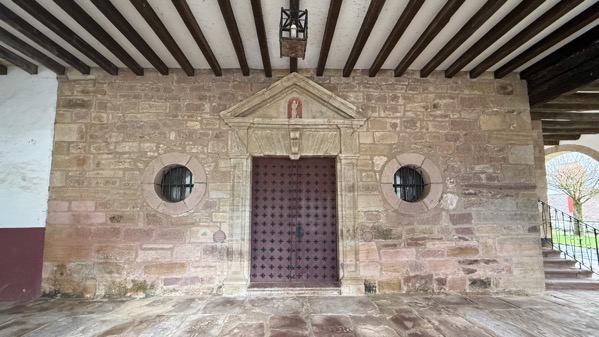
Next door is a church, with a portico over the entrance (seems unusual). Goodnight.
Posted at 2:42 PM |
Comments Off on We enter Basque territory
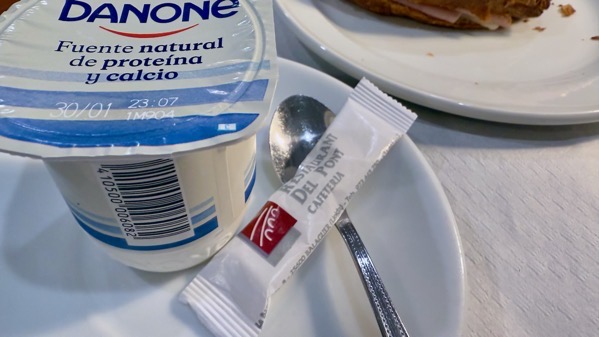
Go to the trouble of getting plain yogurt, yet perhaps you want sugar with it?
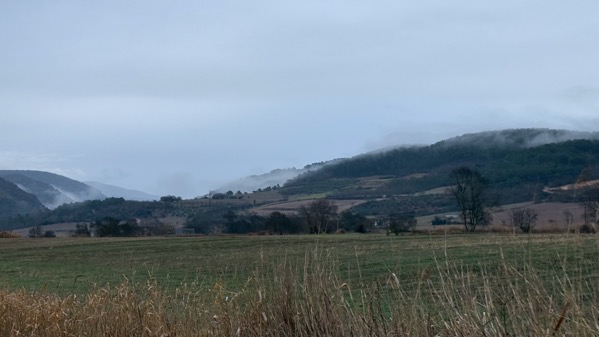
Puffy cloud layers above.
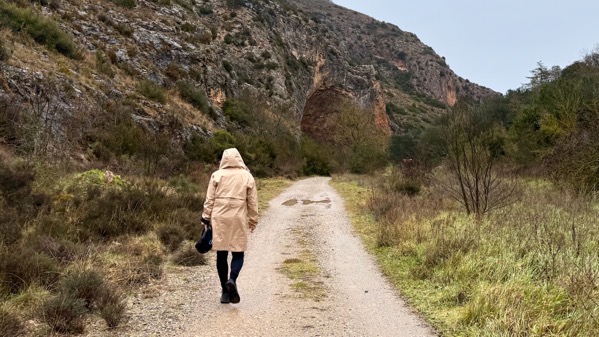
Let’s walk up this scenic valley. What’s that curve in the rock wall?
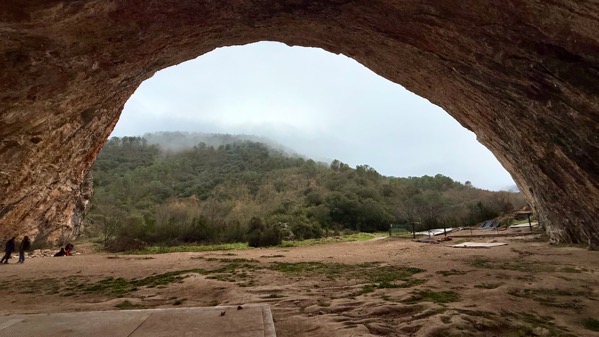
What a giant, gorgeous cave! Archaeologists have found early Upper Paleolithic remains that show repeated short-term visits (not creating deep deposits), including hearths spaced at about 3m apart. These visits are interpreted as related to the seasonal migration of prey species like deer and horses.
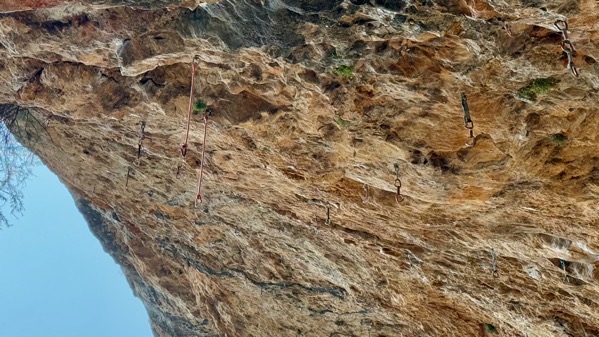
However, current usage leans heavily toward the rock-climbing crowd. I count at least 20 safety helper carabiner lanyards, or whatever they are, on the small section of the roof, ready for the next upside-down adventurer.
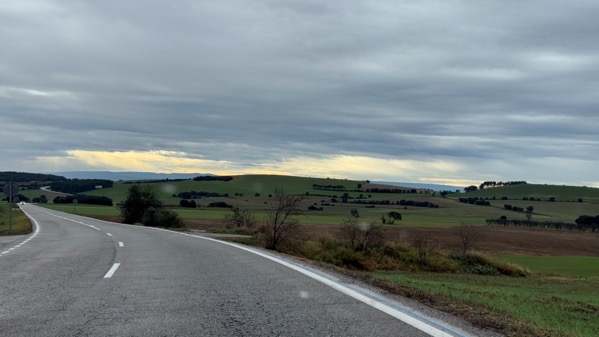
Back on the road, we see signs of clearing.
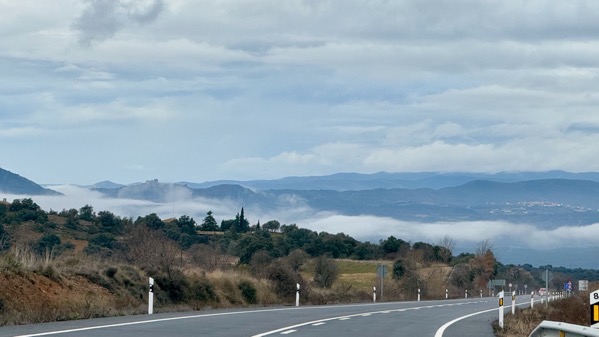
Clouds below, nice.
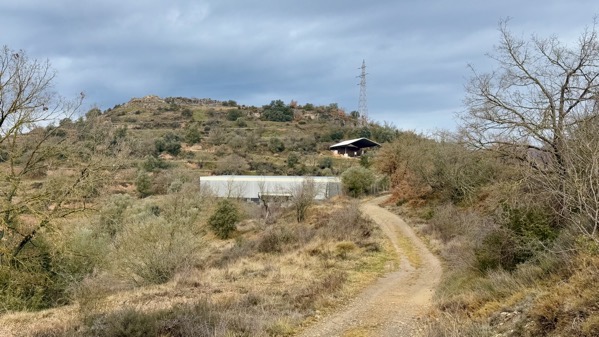
No rain or mist, so we climbed a hill to see this now-scruffy Roman town now called Labitolosa. It had two bath complexes, and a curia and forum, so it was at least locally important in the 1st C BC (so pretty early); it supplanted an indigenous community.

Details of the big bath complex.
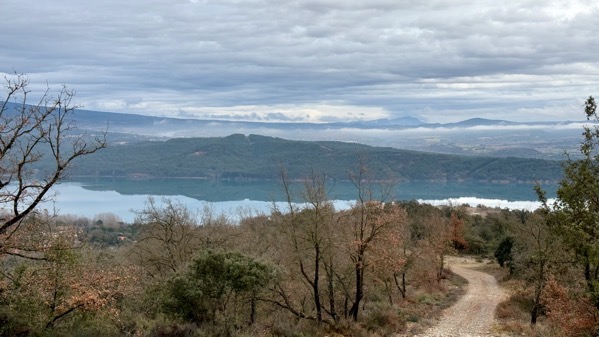
Descending, we could see how still the water of this reservoir was.
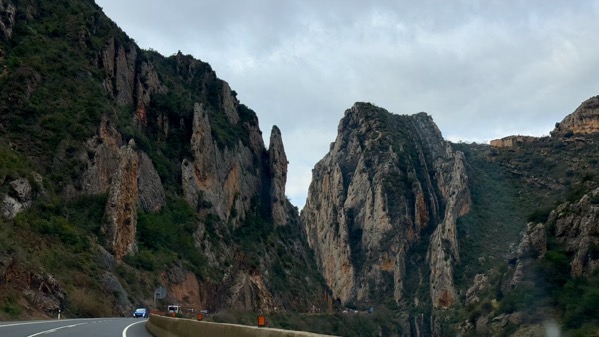
Our route away from that area took us through this stunning gorge.
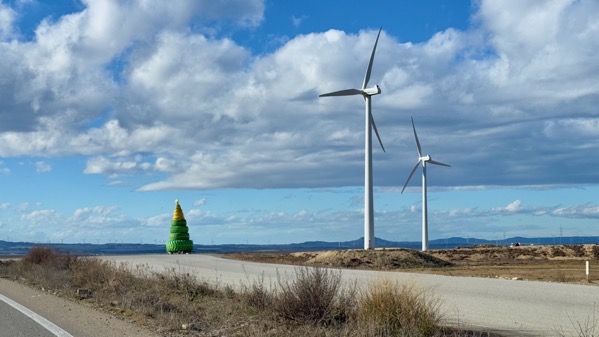
Soon, we were out on what I’m calling the windy flats, here with a bonus tire sculpture.
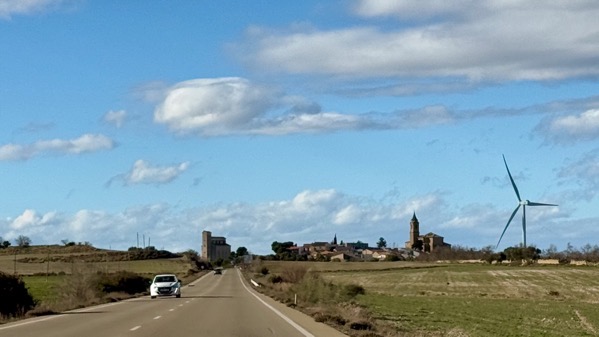
Scattered towns seem lightly active with farming.
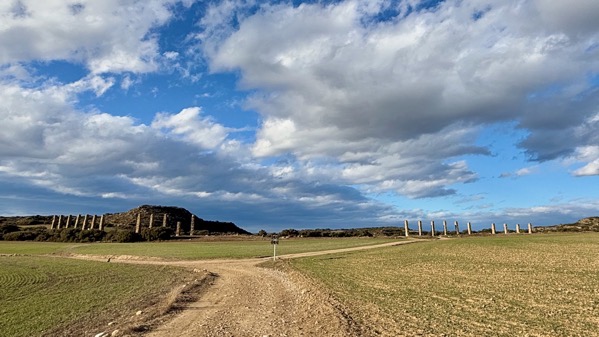
Much further along, we checked out these Roman aqueduct piers (actually vertical—it took a wide shot to get them all in).
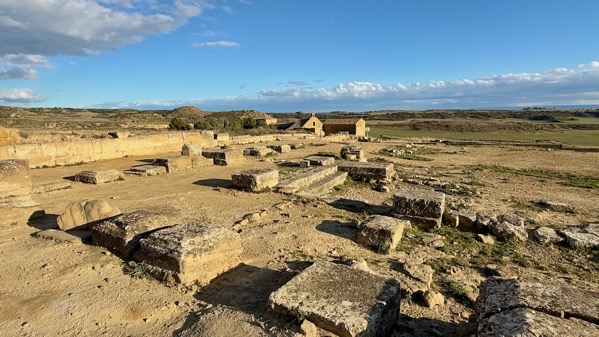
The Roman town the water supplied is today called Los Bañales. This area was the forum. The later building complex in the background is called Ermita de Nuestra Señora de Los Bañales. One record I found dated some of its architecture to the 1740s.
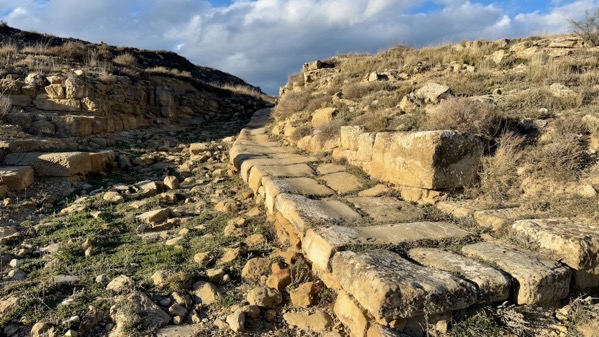
Here’s a section of road connecting housing above the civic-ceremonial zone that included the forum.
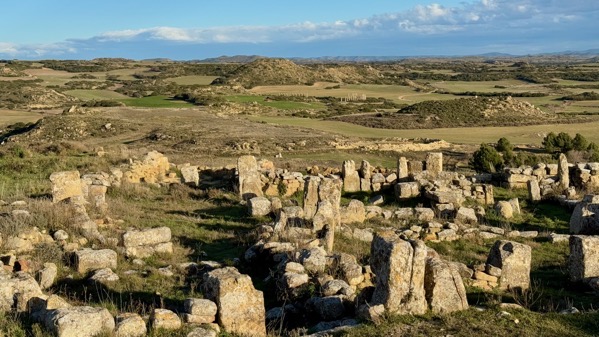
Here’s the view down from higher up. The aqueduct piers are visible. This is looking east.
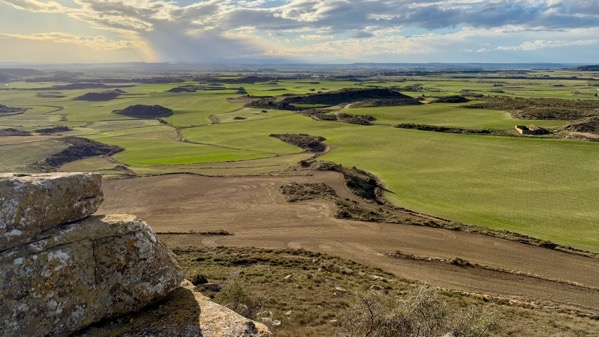
From the top, the light made the landscape look rather different when we looked to the northwest.
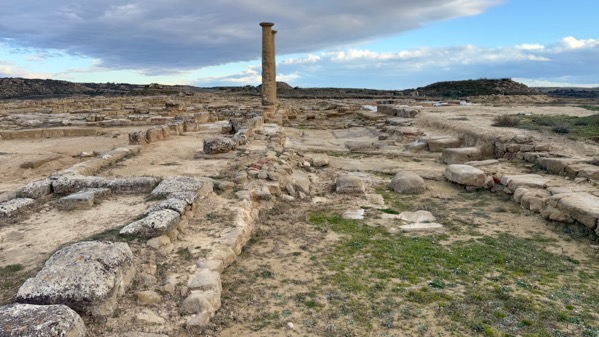
This area is separate from the civic-ceremonial and had many elite domestic complexes. I saw two parallel wide streets; this was the upper one. This settlement was later than Labitolosa, dating to the 1st C AD, so after the Romans had dominated this area for several generations.
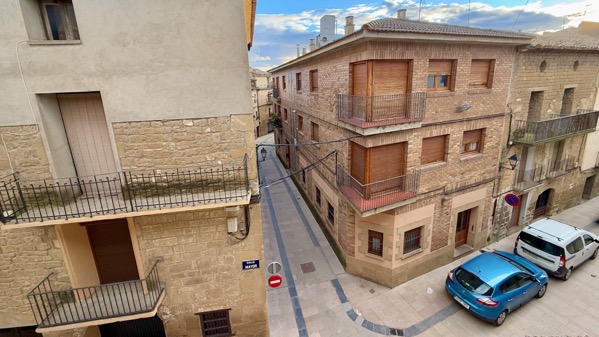
Our hotel is within the old Medieval core of Sádaba, although the façades of the two buildings opposite our room look later. Recent demographic data indicates the highest population of the town was in the 1960 census. It’s less than half that as of 2021.
We heard a story on TV the other day about housing problems in Spain. I think they meant in the large cities, however, as the rural areas we’ve been passing through show a significant percentage of apparently maintained and usable housing that is not inhabited.
Posted at 3:46 PM |
Comments Off on Drizzle, rain, overcast, sun
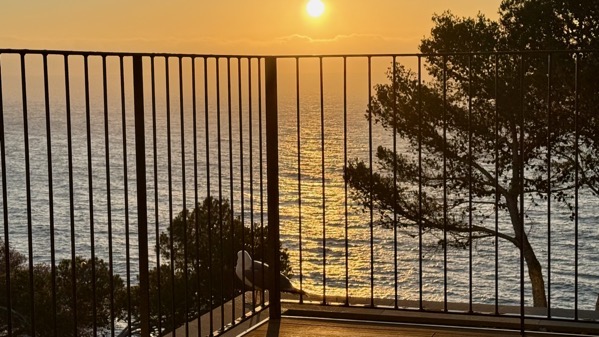
A beggar came by to watch the sunrise with me. Truth: it was more interested in begging than the view.
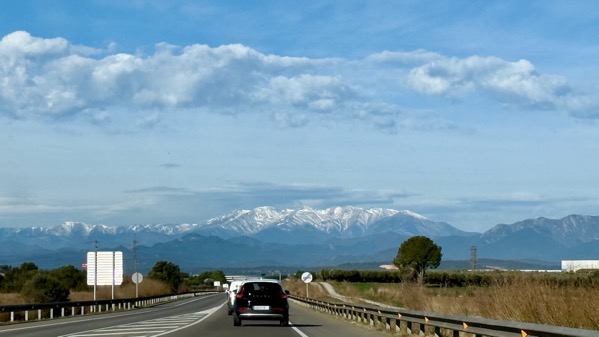
On the road, these snow-caps dominated our skyline to the northwest. We headed first into the mountains out of the photo to the right.
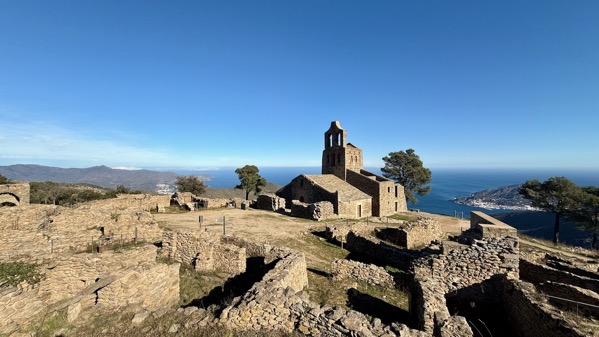
We drove most of the way to this ruin, walking the last hundred meters. This is the Église de Santa Helena de Rodes (sometimes Elena), and the ruins of the medieval town around the church, called Santa Cruz de Rodes. This is a satellite community about a half-kilometer from the Benedictine Monastery of Sant Pere de Rodes. The Monastery was famous for having small relics of THE Saint Peter, which justify the size of that complex, undoubtedly paid for by donations (eh-hem) from the many pilgrims who flocked to this out-of-the-way place.
Rodes is now Roses, on the bay to the south. The central part of the church and most of the bell-tower date to the 10th C (archival mention in 974), although there may have been an earlier use of this location. Several expansions widened the structure and added a portico to the entry.
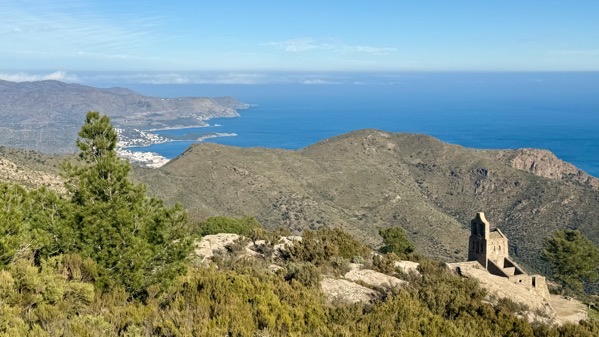
I scrambled up the slope to get this shot. The bushes are woody and tough. Arguably, they make gorse seem wimpy.
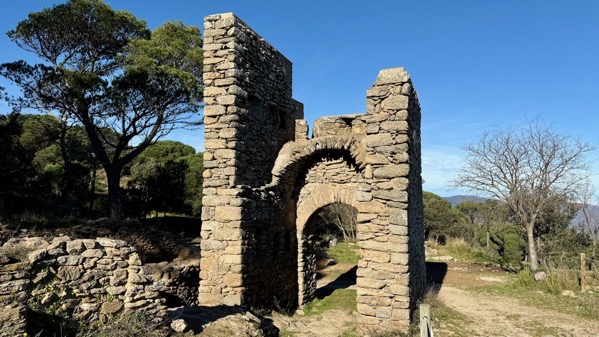
The north gate, away from the monastery, is more elaborate. I’m guessing pilgrims and supplies came from that direction.
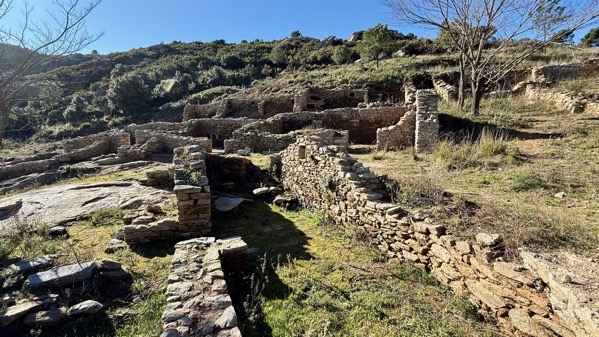
Here’s a closer view of some of the dwellings south of the church and outside the South Gate.
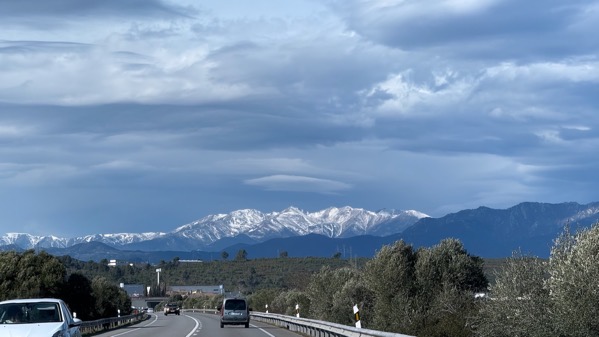
We backtracked away from the church, then continued north. The snow-caps remained to our left (although they don’t appear that way on this bend).
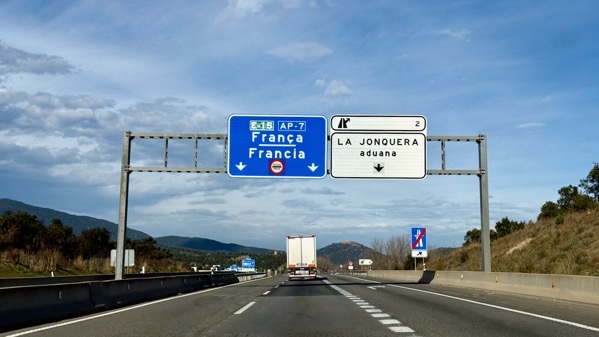
I find it interesting that aduana (customs) remains on the signs, although the building complex is abandoned.
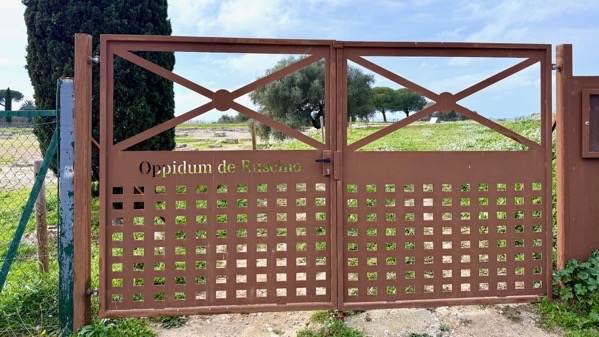
For now the site of Ruscino is closed. This was an important trading center in Greek times, when a string of them were dotted along the coast of the Gulf of Lion. By 218 BC, Livy described Ruscino as walled and hosting boats in river trade…meaning that their principal trade goods came from inland, upstream via the river we now call Têt. I think valuable goods from the Canigó massif south of the river and inland, where there is still a mining area.
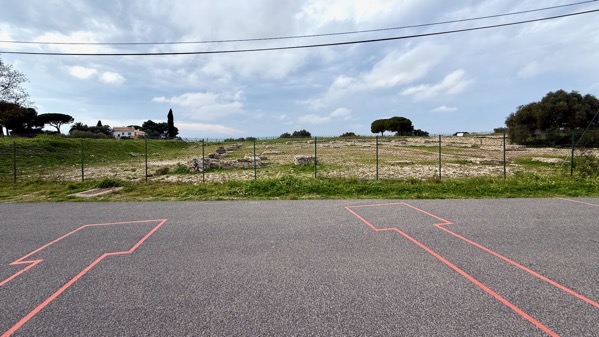
Clever archaeologists have indicated the outlines of walls buried by the road.
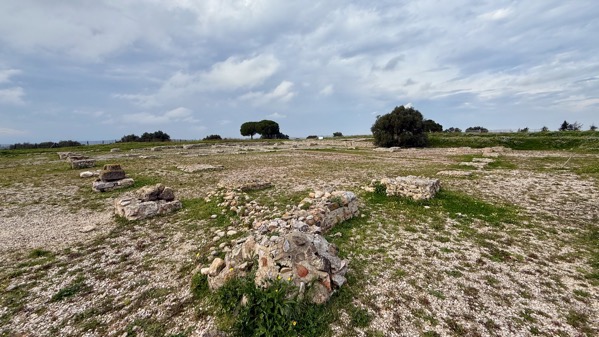
This is a wide shot of the excavated area beyond the fence (west). The historic area of France called Roussillon takes its name from this ghost town. Hannibal and his thousands crossed the Pyrenees somewhere around here on their way from Cartagena toward the Alps.
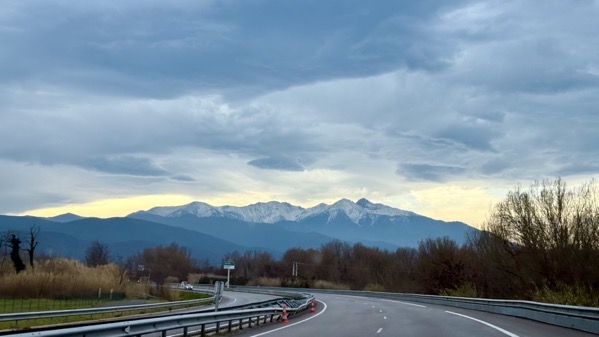
As we continued up the Têt valley, the mountains still attracted our eyes.
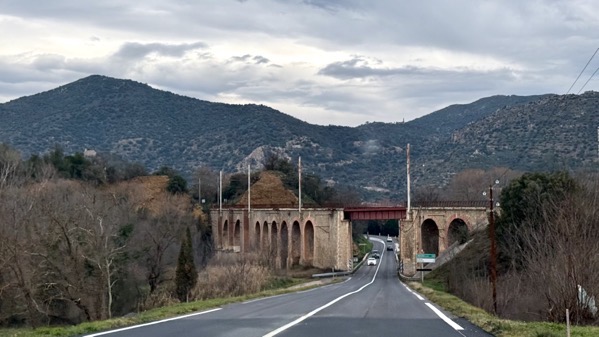
Interesting railroad bridge.
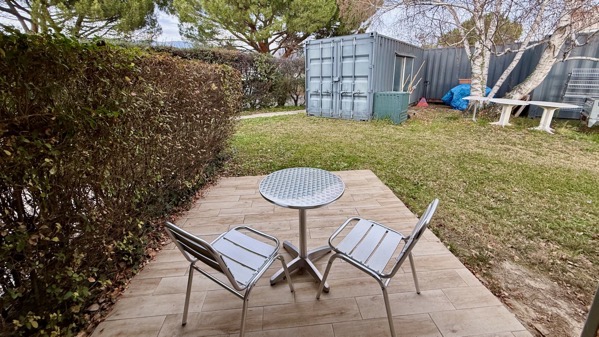
Our room has a sweet patio, sweeter if it were sunny and the shipping container weren’t there. No seagulls, and no sunrise view expected.
Posted at 12:13 PM |
2 Comments »
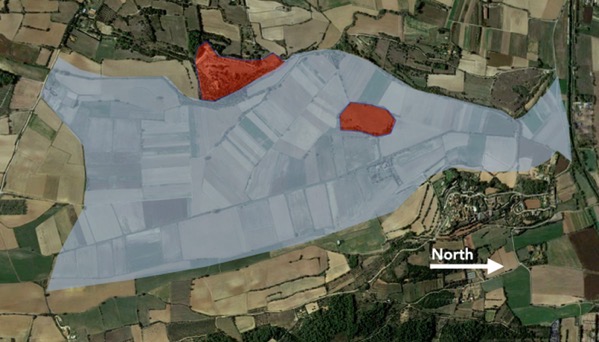
Here’s another pair of settlements, the west one on a hill and heavily fortified with tall walls of large stone blocks, and another on an island in a lake. Both were occupied from the 6th–5th Cs BC (so: Iron Age), thriving even when the Greeks settled at Emporion (see yesterday). Indeed, the walled site was a regional capital, with perhaps 6,000 residents, large grain stores and an active trade with the Greeks in luxury goods. Archaeologists know far less about the island settlement, and it is not open to the public, so I know even less. The Romans conquered the territory at about the end of the 3rd C BC, and these settlements were abandoned in the 2nd C BC.
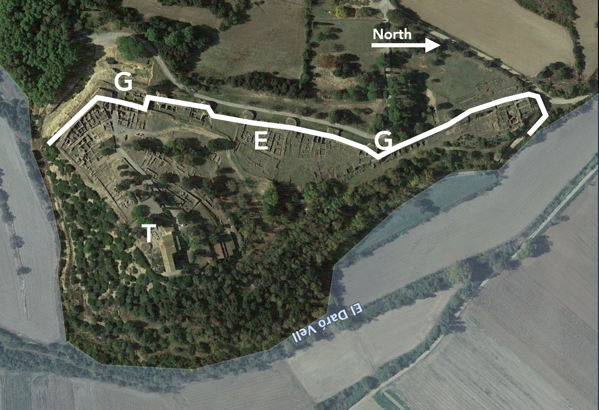
The layout of the capital is interesting, with the lake to the east and south, and a major wall along the other sides. I’ve drawn in the wall, and the bumps along it are large, round towers plus two angular ones. “G” means gate. We entered the South Gate, and outside it is a deep moat. “T” indicates a pair of temples that were built on the summit of the hill. “E” is an elite domestic complex, huge, and it has produced most of the fancy, expensive goods found at the site. The name archaeologists use for this site is Ullastret, which is the nearest town, and no relation the name its residents used.
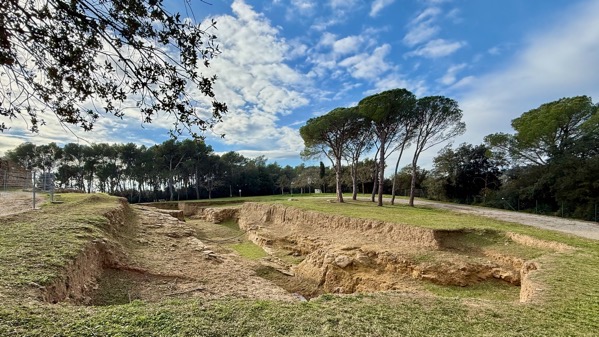
Ditch outside south gate, view south.
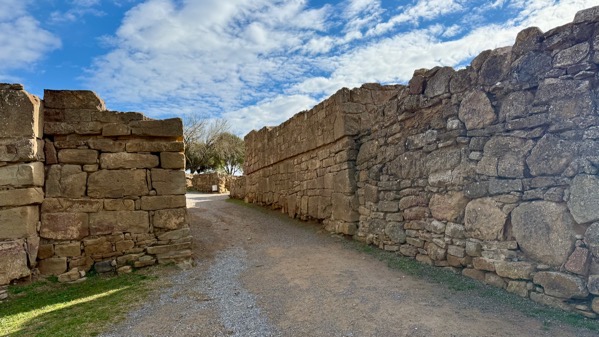
South gate, view east, looking into settlement.
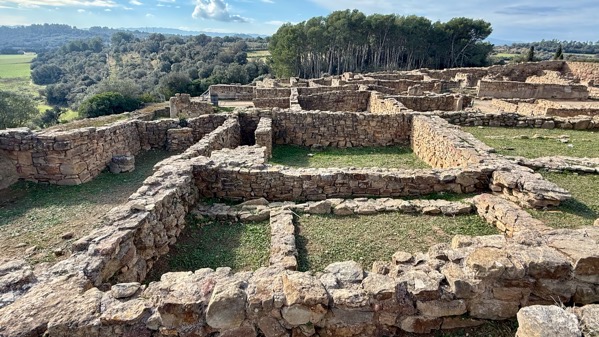
Houses in the southwest part of the site.

Archaeologists call these silos, which makes sense as they are round and were for storing grain. Only the bases, which were excavated into bedrock are visible now. When used, they had conical tops with a small opening at the peak made of a mixture of mortar and ground discarded terra cotta. They were lined with the same mixture, and apparently totally sealed when finished. What surprised me is they were not reused—I hypothesize it’s because they couldn’t be properly sealed again.
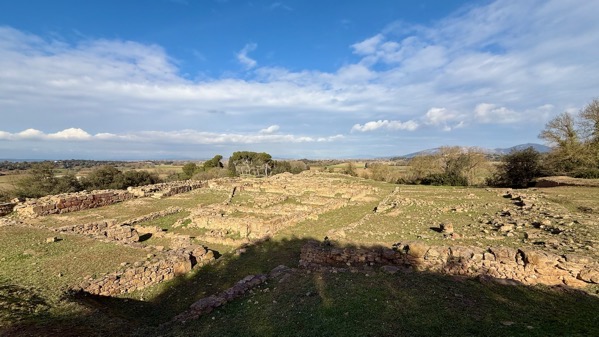
The left half of this area is the elite complex. It had its own small gate through the defensive wall. The interpretation is that it was used by a large family unit. I don’t know any of the details of what archaeologists found here, but I keep thinking it may have been an area used by a guild of traders—but were there such groups?
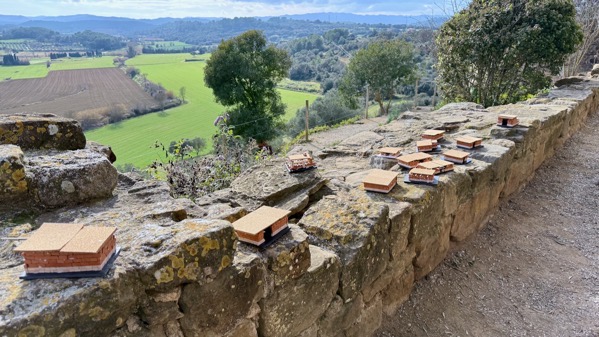
Plopped on the hilltop, obliterating one of the temples, is a church that is now a museum. Today a student group was making house models with glue and blocks and cork roofs.
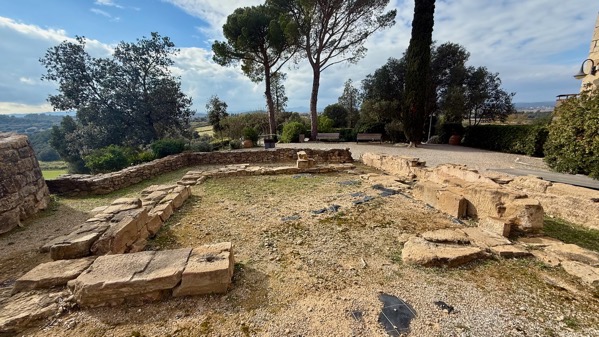
Here’s the foundation outline of the surviving temple. It seemed pretty good-sized to me.
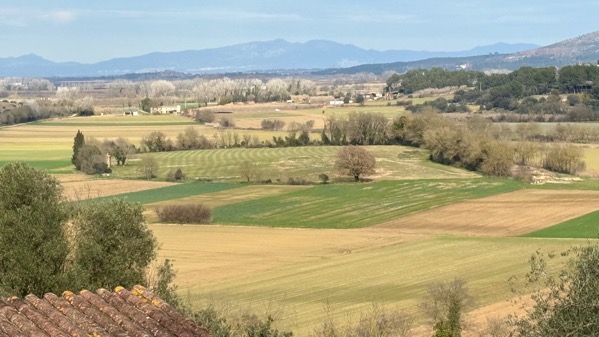
That almost complete circle of trees is the island. Imagine this view when the lake still spread around it.
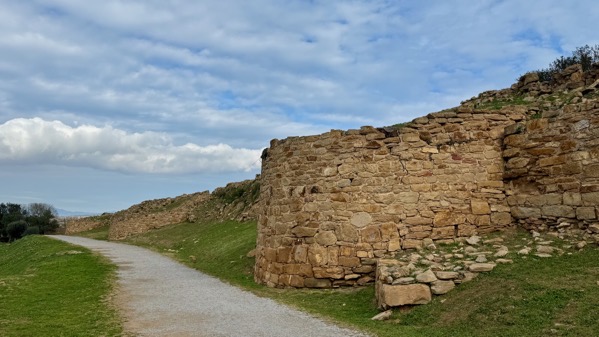
View north along the outside of the towers. Formidable.
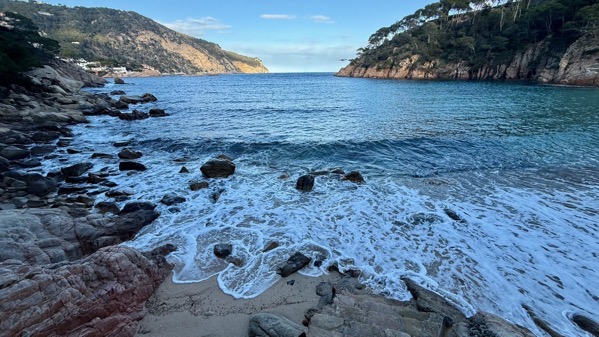
Not yet high tide on the beach near our hotel—I’m guessing as the rack line is still dry.
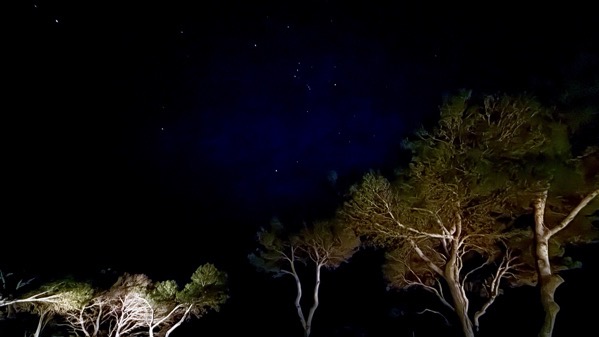
Three-second exposure from our balcony a few minutes ago: that’s Orion in the middle…I hope the resolution isn’t so hammered it erases him! [Zooming will help.]
Posted at 1:57 PM |
Comments Off on Two more settlements

Orientation first. Left satellite view; this is the southern Gulf of Roses. On the right is Greek Emporion (amplified right), Roman Empúries (left lower, with “R”). North is “up.” The scale is huge. IMHO, these were cities, not ho-hum towns.
First, however, indigenous people lived in the area. Although later occupations have covered them up, that round knob at the top, an island with an elevated summit, was an Iron Age settlement, and inland were others.
Greeks were trading here before establishing a settlement. They first built on the knob to trade, and called it Palaiaopolis; the harbor was to the south of the island. Celt-Iberian pottery was changing from this presence by the 7th C BC. In the 6th C BC, Greeks moved to a new area to the south of the harbor; they called it Neapolis. This community was given repeated updates and modifications. By the 4th C BC, this was a city with a Greek layout—including an acropolis on the highest spot, and markets and an agora, the central public space. In the 2nd C BC, they beefed up the walls, expanded the sanctuary areas, and added new port structures.
You can research the warfare/conflict that gave the Romans the upper hand by the 1st C BC. On the left, the rectangular “R” area is the Roman city. Ultimately, the grid of streets was 6 or 7 wide, and 15 north-south. The amphitheater is just outside the wall south of the southwest corner.
Now, some photos of the Greek city.

Sarapieion temple, southeast corner of Emporion.

Peristyle domestic complex, the largest of Emporion, close to the bay and immediately south of the agora.

View east-southeast, with stoa along the left (colonaded public structure), and agora in mid-ground.

View south from houses north of the agora, down the main north-south street of the southern part of the city.

Port—now green grass and trees; view north.

Acropolis. View is to the north. I found it amazingly small, perhaps 5×5 m.

Somehow this is a water filtration system, up near the acropolis. No info was offered about how it worked.

This gives an indication of the density of houses (almost all of these rooms were dwellings/dwelling complexes), looking toward the acropolis from the main north-south street, view to west.

They’ve put a museum in the church, between the two cities. This statue was found in 1909 in the temple area in the southeast of the city. The upper part was in a cistern, and the rest in the temple where it stood originally, and a replica stands now.

From the museum, we ascended the hill and entered the Roman city. It is vast. This view is from the northeastern edge of the excavated area, looking south. I’m pretty sure all of what you can see, except perhaps the tallest trees, lies within the city (maybe not the walls, but the city).

Here’s looking the length of the forum from the north. I’m standing on the front of a large temple honoring Jupiter, Juno, and Minerva. Colonaded structures lined the other three sides, and more temples flanked this one on the north side. Again, all but perhaps the tallest trees: in the city.

Looking north through the door/gate in the south wall, up the main street, the length of the city. Ish. That partial structure on the left is a reconstruction of the southwest corner of the forum.

Outside the wall, but snugged up against it is the amphitheater. The vertical element is gone, and I find it difficult to visualize its scale.
Well, that’s enough. Remember, too, that, big as this Roman city was, the whole population of the immediate area was not living here. Indeed, there were other communities and villas scattered about. ’Nuff said.
Posted at 12:54 PM |
2 Comments »

A wee bit of scientific data: the sun indeed rose again today.

For today’s adventure, we drove north. I saw these fields before, and thought: rice. This is now confirmed. Rice. Good for cazuela cooking, like paella (a specialty of Valencia, way south of here, as I understand it), but there are other regional dishes using the same or similar shallow, flat-bottomed, metal pans.

We have also been seeing these plantations, and I now think most are apples, although some may be pears or similar. The orange orbs are I think insect traps. The black lines on top are folded shade cloths.

Our main stop was huge—the Ciutadella walls etc. were ordered by Charles V, Holy Roman Emperor, in 1543. Its on the north shore of the Bay of Roses. However, this fine location on a good harbor was settled by Greeks, and I suspect had earlier inhabitants. The Greeks called their settlement(s) here Rhode. To decode: the red G means Greek structures. The aqua R means Roman. The yellow means Medieval, and MC is the Medieval church. Some of this is later than Medieval and un-labelled. These are the parts that are very visible and/or most interested me.

The encircling wall is massive.

The marked rivers/creeks are approximately how they were in Greek times, and this is the Greek settlement area to the right/east of the “right” creek. The shoreline at the time was inside of what later became the Ciutadella wall. When it was built, seawater lapped the south wall base.

Here’re Roman foundations. There’s no difference to my eye between Greek and Roman here—similar scales.

On the west side of the interior of the Ciutadella, this view is north toward the Medieval Church, a major street that had buildings lining both sides.
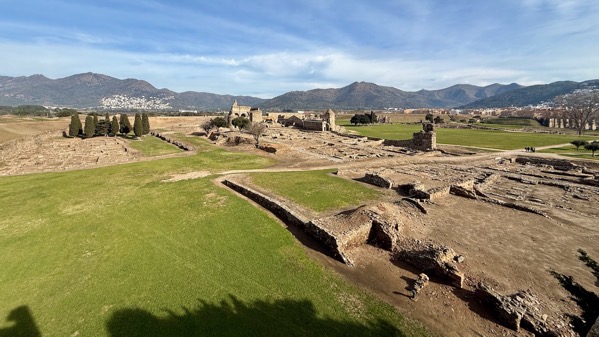
This bird’s eye(ish) view is from a tower in the northwestern part of the southwest corner.

Perhaps you can tell from the previous two photos that the church is on a hill. It also had Greek buildings, and archaeology shows they occupied at least three places along the northern arc of the Bay of Roses.

Homework: create your own caption….

Moving on…. That hilltop above the scrub is the ruins of a Visigothic fortification, dating to the 7th and 8th C AD. It’s called Puig Rom and does have good views of the Bay of Roses, not shown in any of these photos. The word puig is Catalan, and it’s tough to pronounce…it’s something like poo-ee-[th], but the [th] has an almost guttural aspect.

Puig Rom has an encircling wall with only one gate/break in the wall (center). Houses have been exposed inside the wall about ¾ of the way around.
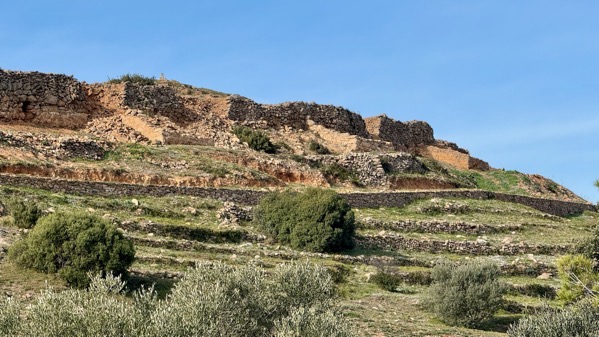
On this side, there are also houses outside the wall. The other sides are rather steep, but there are narrow terraces, so they may have house foundations.
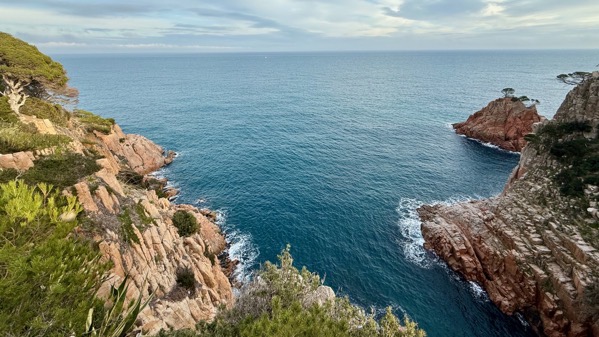
And, we returned to our oasis by the sea…always the sea….
Posted at 12:42 PM |
3 Comments »

What a first peek outside our window!

And there’s the sun! [Forty-four minutes later, but who’s counting??!!]
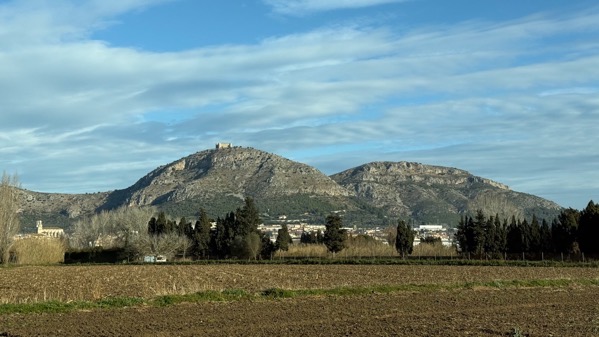
Off on our adventures, aha, there’s the first castle we’ve spotted, waaaay up high.
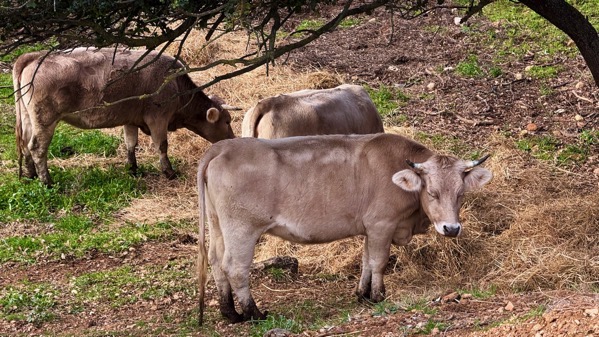
We enjoyed the last few meters before reaching an Iron Age village, along with munching cattle. [For the amount of dairy and pork we see on the table, we see remarkably few of those critters in the countryside.]

And there’s the settlement…with working archaeologists! Actually, looking at recent maps, that is the highest settlement area; more is “behind” us/me. But what’s exposed is ahead….
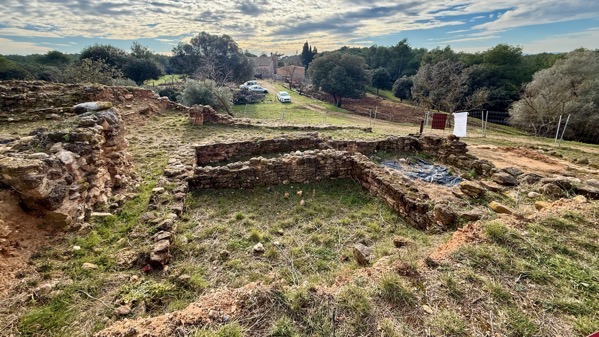
This rather large room produced multiple Greek and greek-style artifacts, including large ceramic vessels. This settlement was well-connected with Mediterranean coastal trading ports, undoubtedly Empúries, 12 miles away as the crow flies, so a day’s walk if you were in good shape and the path wasn’t muddy.
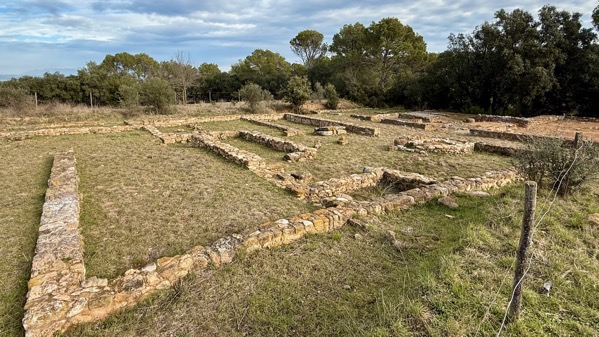
This area was built later, and some houses had even larger rooms.
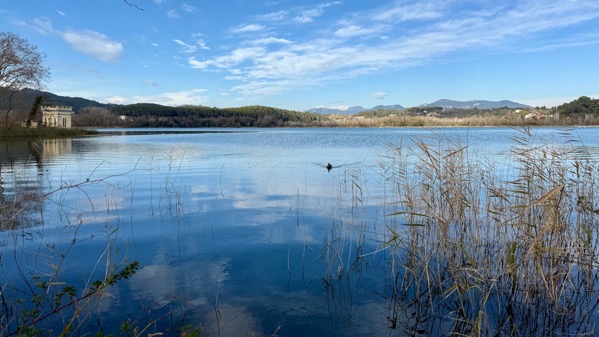
Next stop: Lake Banyoles, the largest lake in Catalunya, and long renowned for its fishing.

Cormorants look like cormorants.
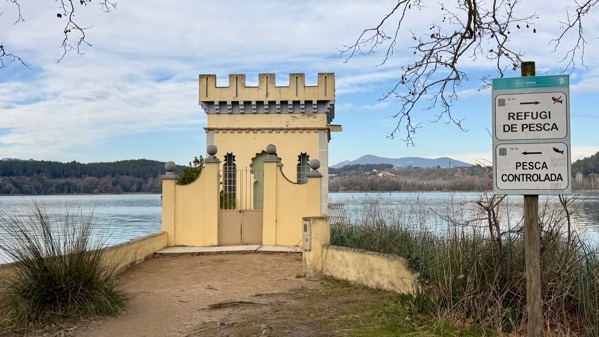
Early 20th C fishing (and bathing) “hut”—there’s more than a dozen spaced along this stretch of the shore.
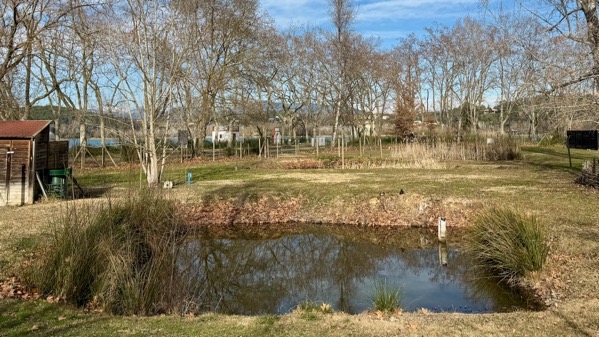
However, people fished Lake Bangles even in the Neolithic. This hole is a below-the-water-level excavation that has now re-flooded. The water kept organic artifacts from rotting away, preserving wood, basketry, bones, seeds, and textile matter that’s usually totally absent. Archaeologists also found the remains of buildings, including structures on pilings.
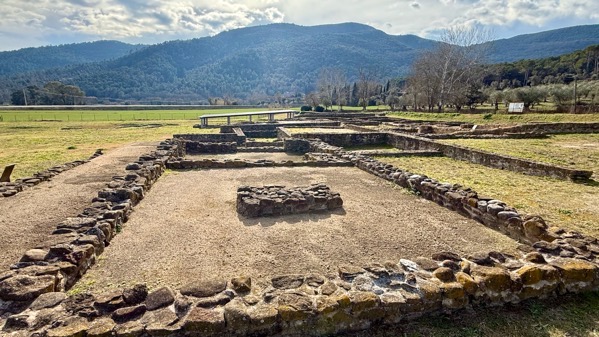
Today’s Roman site is a farm called Vilauba. It began as a U-shaped building from the 1st–3rd C AD. Later, more rooms were added through the Visigothic period. This was the location of the press (represented by that interior rectangle of stone), probably for olives (I should have read the signs more closely, but: Catalan).
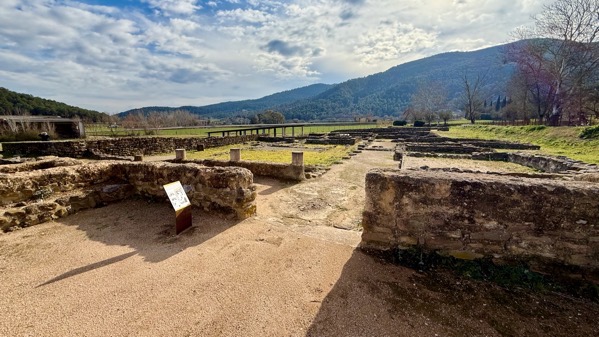
Speaking of Catalan, this room was a “rebost”, meaning pantry. The raft of pottery containers found here kept various foodstuffs and items (relatively) safe from critters and insects.
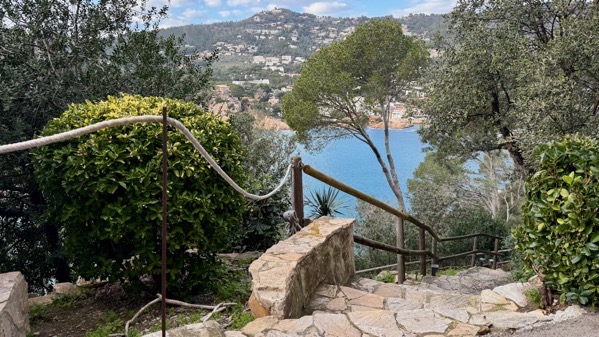
Back at our hotel, I took the trail down down down…
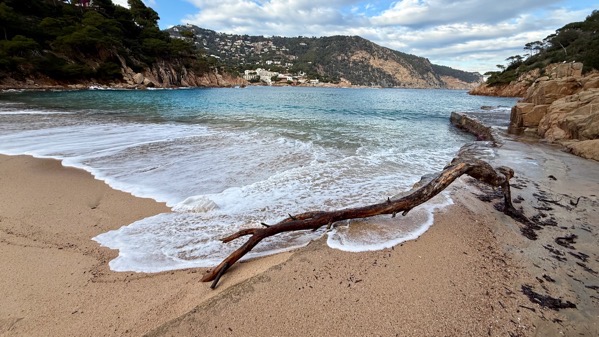
…to the beach. It’s pretty much high tide, I think.
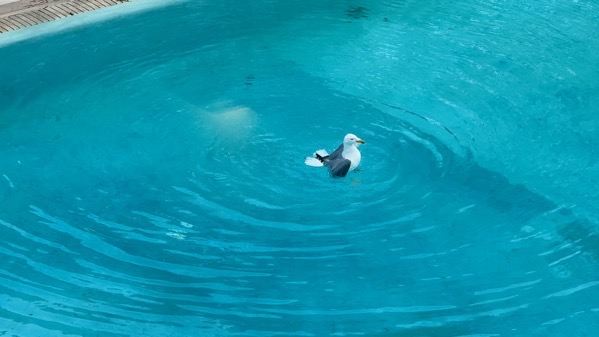
Back up at the hotel, I spotted a gull taking a bath in the (closed for the season) pool. I shot a series of photos and discovered it turned its head to the right every time it ducked (is that term okay?) under. Here it’s fluffing its wings and tail.
Posted at 12:37 PM |
2 Comments »
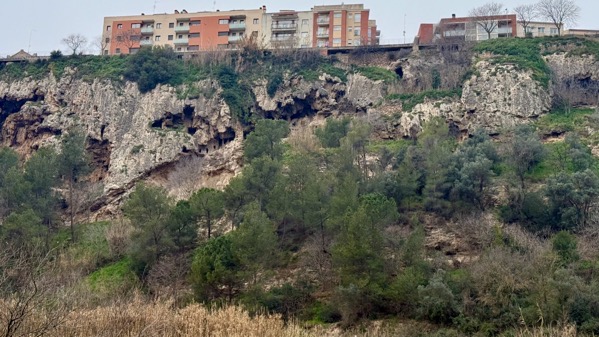
Leaving Capellades via the highway in the valley, we looked back up at the Quaternary travertine cliff formation. Here I see probably more modern housing carved into the soft-ish rock, but not the caves. Still: interesting.
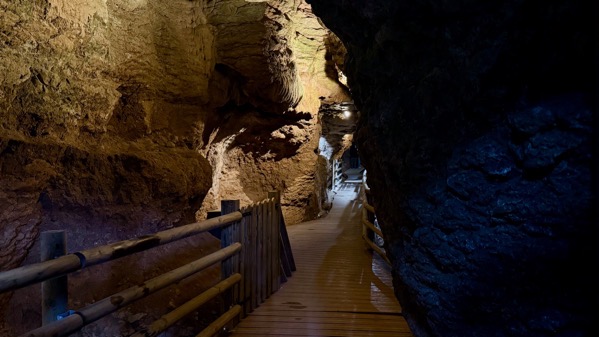
We visited a geopark in a valley lined with caves. We didn’t arrange to enter them, just walk the path in the valley, and peek through the bars. Cova del Toll.
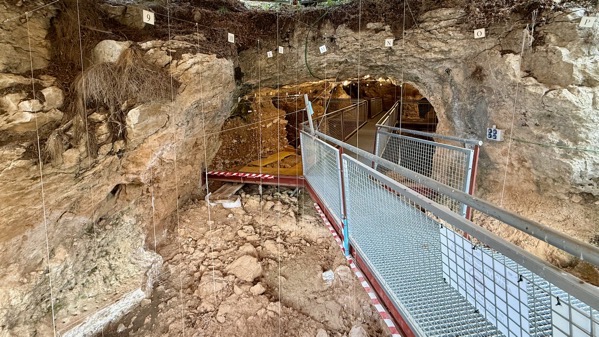
Cova del Toixoneres (Catalan spelling), usually Teixoneres in the academic literature. The strings outline 1 m squares to trip the workers…um, to make it easier to keep locations straight.
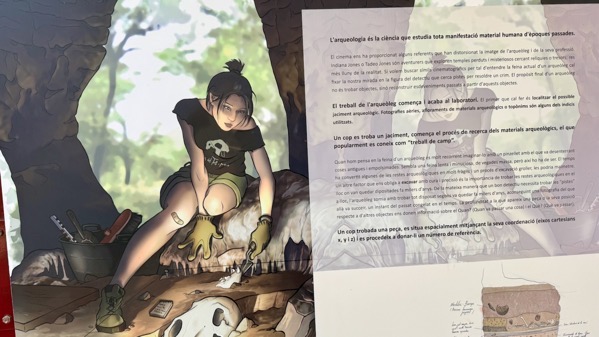
Artistic rendering of comely young archaeologist.
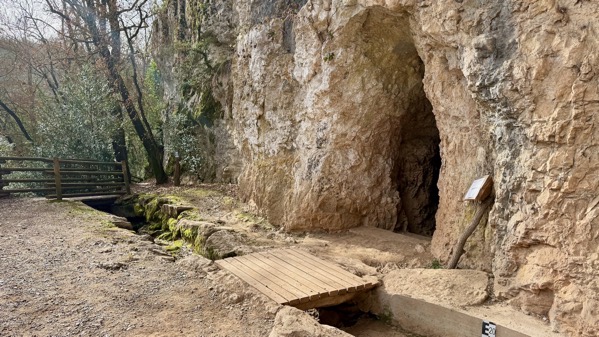
Cova Morta. They get significant runoff here at times, I’m guessing.
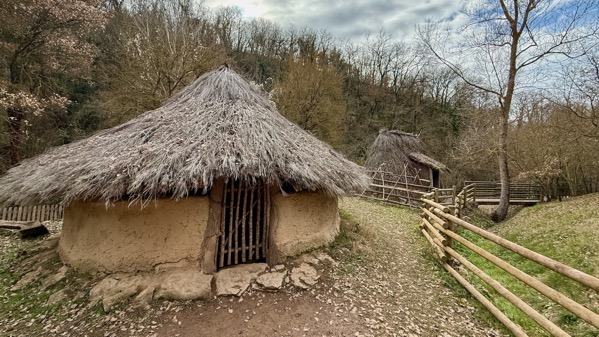
Reconstructed Neolithic huts.
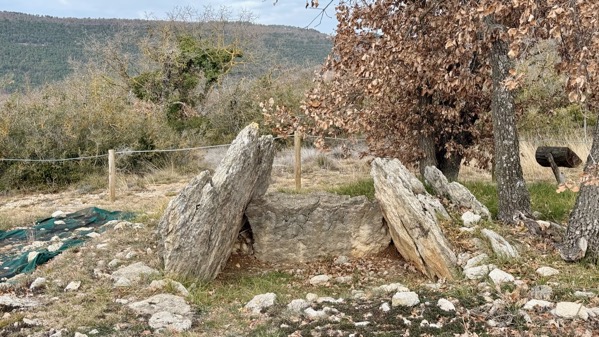
Beside the access road to the cave-valley: dolmen de Cuspinar, dating to the Chalcolithic (sometimes called the Copper Age), so after the Neolithic.
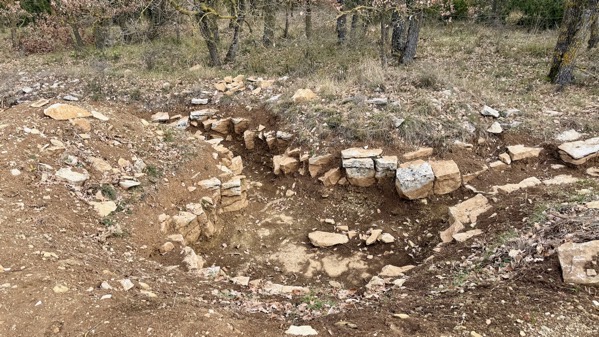
Also by the access road, Republican trench from 1936.
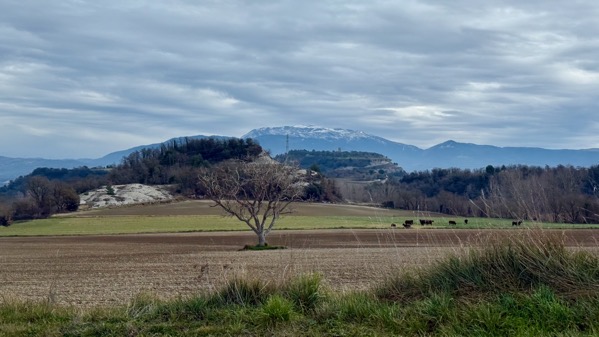
Roadside view—high-elevation snow.
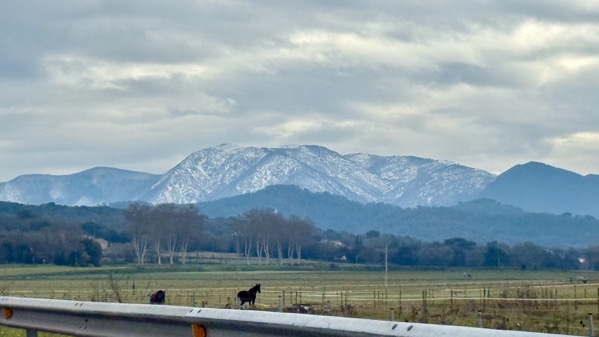
Heights with snow; horses in foreground (ignoring guardrail).
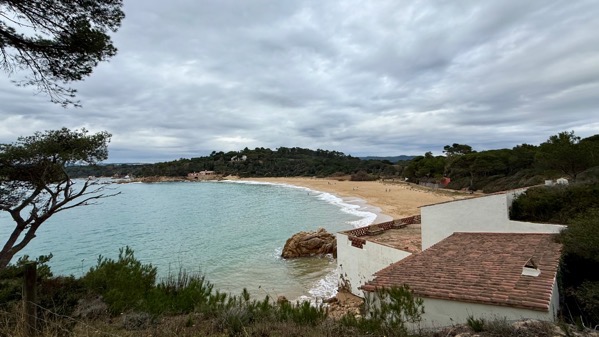
Our first view of the Mediterranean: Playa Castell walking to the Castell.
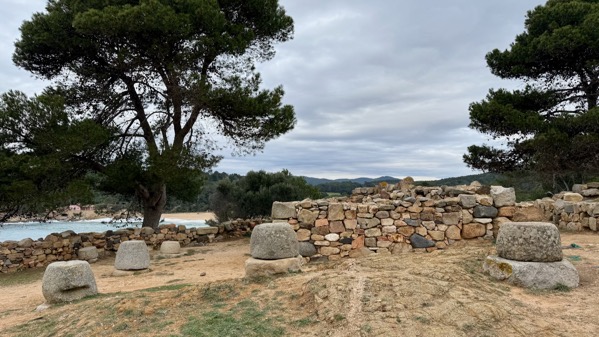
Look at some of the huge stones at the Castell de la Fosca, a promontory fort. Ascending to the top is no longer permitted, but at this level, inside the protecting wall at the neck of the peninsula, excavations produced datable remains. The first occupation was in the 6th C BC, in the earlier Iron Age—several small semi subterranean huts, then abandoned. The site was reoccupied in the mid-5th C BC, and the hut depressions were used for garbage. The maximum population was in the 4th C, and into the 3rd C BC, when buildings were built on terraces along both sides of the landform. The presence of column bases (shown here), of imported stone, and other features suggests there was a public building, possibly a Hellenistic temple, on the highest point in the community. Both Greek and Phoenician trade goods are among the pottery/material culture recovered by excavation, although most artifacts are of indigenous types/styles.
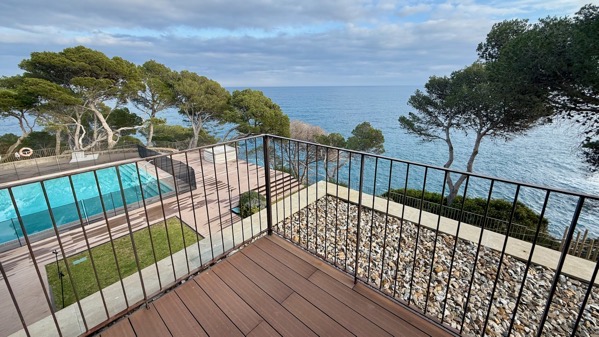
Enough archaeology. We have arrived at our home away from home for the next six days, and the splurge of the trip. Here’s our private patio and our sea view. Lovely.
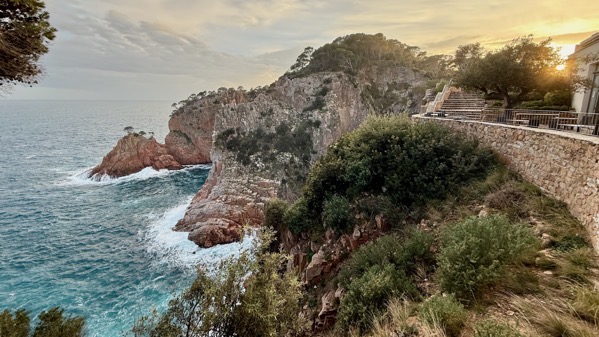
From the secure railing, here’s the view down onto the rocks where the sea is crashing.
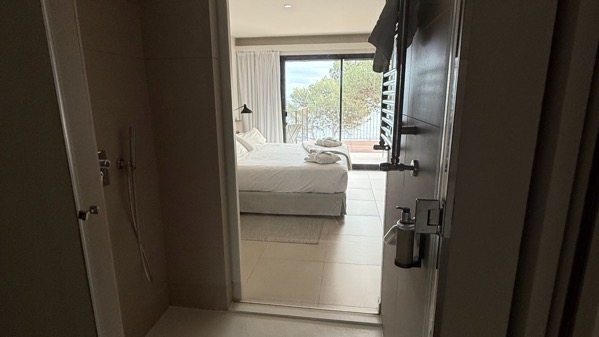
The room is designed so you can chose to shower watching the Mediterranean—at least until the glass steams up! Dinner at 8pm tonight (we chose early), petit breakfast at…we chose 8:30am. Off to eat, sleep, eat. Good night!
Posted at 12:48 PM |
Comments Off on Caves, fortress, sea views























































































































































